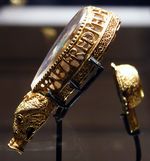Alfred Jewel
The Alfred Jewel is an Anglo-Saxon ornament dating from the late 9th century, discovered in 1693. The Alfred Jewel was made in the reign of King Alfred the Great and is inscribed "aelfred mec heht gewyrcan", meaning "Alfred ordered me made". It is about 2½ inches (6.1 cm) long, made offiligreed gold, enclosing a highly polished piece of clear quartz "rock crystal" beneath which is set a cloisonné enamel plaque, with an image of a man, perhaps Christ, with ecclesiastical symbols. The figure "closely resembles the figure of Sight in the Fuller Brooch, but it is most commonly thought to represent Christ as Wisdom or Christ in Majesty".[1] It was at one time attached to a thin rod or stick based on the hollow socket at its base. The back is a flat gold plate engraved with "an acanthus-like plant motif".[2]
The jewel's purpose is unknown and remains a source of speculation. It has been suggested (not based on any factual evidence) that it could have been a pointer stick (for following words when reading a book), part of a crown, or part of a brooch. It may have been one of the precious "æstels" Alfred had sent to each bishopric with a copy of his translation of Pope Gregory the Great's book Pastoral Care - no context is given in the document mentioning these, or elsewhere, but it is thought they might have been pointers. David M. Wilson sounds a note of caution as to the connection with the King, noting that "in a period when royal titles meant something, there is no royal title in the inscription".[3]
It was discovered in 1693 at North Petherton near Bridgwater in Somerset on land owned by Sir Thomas Wroth (c. 1675–1721), where King Alfred founded a monastery. North Petherton is about 8 miles away from Athelney. The Alfred Jewel was first published in 1698 in the "Philosophical Transactions of the Royal Society" and bequeathed to Oxford University by Colonel Nathaniel Palmer (c. 1661-1718) and today is in the Ashmolean Museum in Oxford, England. A replica of the jewel can be found in the church of North Petherton.
Use in popular culture
The Inspector Morse episode "The Wolvercote Tongue" centres on the theft of a fictional Saxon artifact based on the Jewel.
In Susan Cooper's book The Dark is Rising, one of the six Signs of the Light, the Sign of Fire, is based on the Jewel. It also is made with gold and bears the inscription "liht mec heht gewyrcan", or "The Light ordered that I be made".
Similar Jewels
Since the discovery of the Alfred Jewel, six similar objects have been found. All are smaller and less elaborate, but are traceable to the same period and have a socket like that on the Alfred Jewel, suggesting that they were made for the same purpose.
The Minster Lovell Jewel -- this is the most similar to the Alfred Jewel, consisting of a round gold disk that contains an enamel plaque of a floral design. It was found in Minster Lovell in Oxfordshire, and is kept at the Ashmolean Museum. [4]
The Warminster Jewel -- this consists of filigreed gold strips containing a white glass stone. A small blue glass stone is held in the middle of the jewel where the gold strips meet. This jewel was discovered in Warminster in Wiltshire and is held in the Salisbury and South Wiltshire Museum. [5]
The Bowleaze Jewel -- this jewel is made of patterned gold with a blue glass stone in the middle. It was found at Bowleaze Cove near Weymouth, Dorset, and is kept at the British Museum. [6]
The Yorkshire Aestel -- this resembles a golden animal's head with blue glass eyes, one of which is missing. It was found in Aughton, Yorkshire, by Tim Pearson[7] and was sold as "lot 312" in Bonhams Antiquities auction, Wednesday 15 October 2008 for ₤10,800[8]. A picture is available [2]At the time of writing, this is the only privately-owned aestel.
The Borg Aestel -- this jewel is decorated with a pattern of spirals of gold wire. It was found in the ruins of a Viking Chieftain's hall at Borg in the Lofoten Islands in Norway, and is now in the Lofotr Viking Museum. Alfred is known to have been visited by a powerful trader called Ottar, who was native to the Lofoten Islands, so it is possible that Alfred gave the jewel as a gift to him.
The Bidford Bobble -- this is the smallest of the jewels. Its round head is made of patterned gold with blue and red enamel pieces. It was found in Bidford-on-Avon in Warwickshire and now belongs to the Warwickshire Museum service.
All seven jewels were exhibited together for the first time in Winchester Discovery Centre between February and May, 2008, as the centrepiece of an exhibition of relics of Alfred the Great.










Aucun commentaire:
Enregistrer un commentaire